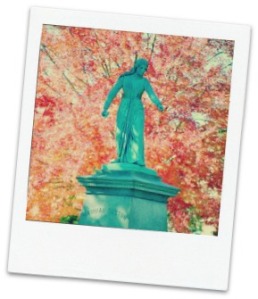Surrounded all around by a sea of freshly manicured green grass and the shade of mature trees, there stands a statue in complete contrast to the pastoral scene around her. Her large and muscular frame, enmeshed in a metallic interpretation of Puritan dress, gives the impression of a lady not to be messed with. Her square-jawed face is locked into an expression of determination, whilst her eyes blaze with the fire of a warrior Queen. This is no Hester Prynne depicted – no weaker vessel woman – but a veritable seventeenth-century Boudicca. The viewer seeing her powerful stance may be reminded of Lady Liberty, yet that is no beacon of welcome in Hannah’s hand. In her grip lies a tomahawk. A tomahawk which should have been depicted covered in gore from the massacre and scalping of a Native American family. Two women, two men and six children died at her hand. She received £50 from the General Court at Boston for her bloody harvest of scalps.
Hannah Duston’s tale lies in the murky melee of Anglo-Indian relations in the latter half of the seventeenth-century. In the age old cycle of colonisation, traceable across the American colonies, by the time of Hannah’s capture the image of the Indian had been transformed from a pliable would-be converso to a murderous quasi-demon. Competition over resources, trade and territory shifted the attitude toward native Americans from patronisation to out and out violence and distrust. By King Philip’s War, named for the English predeliction to anglicise native names, the common people of Boston were so full of ‘animosity and rage’ toward the Indian they had set out to convert, that four hundred westernised ‘friendly’ Indians were rounded up. They were marooned upon Deer Island in Boston Harbor to face the harsh winter unprotected. Their having accepted Christianity provided them no mercy from the Puritans of the Massachusetts Bay. Chalk and Johassohn’s The History and Sociology of Genocide has gone so far as to argue the treatment of the Indian in this period as an early historical example of ethnic cleansing.
It was in 1697, five years after the infamous Salem witchtrials. that Hannah, her husband and children where set upon by Abenaki Indians. Her tale of woe, the murder of members of her family and kidnap was quickly seized upon by Cotton Mather in his Decennium Luctuosum and Magnalia Christi Americana. Her tale, in a similar vein to Mary Rowlandson’s, fits into a wider genre of captivity narrative popularised in the period. Despite the odd reference to the ingenuity of the Indians oneness with nature, her tale fuses turmoil and suffering in the wilderness at the hands of a Devilish band of Indians with the ideas of religious awakening central to Puritan ideology. Her massacre of her capturers therefore portrayed through religious imagery as justified and Godly.
Such accounts of Hannah have led to her ascension to the great hall of (white) American heroines, a testament to this is of course her statues in both Massachusetts and New Hampshire. A brief Google of either the name Hannah Duston or Dustan will fill your browser with a variety of webpages claiming her proudly as kin or pronouncing this ‘crazy hardass’ as ‘badass of the week‘. You can buy a bobblehead of her clutching a plastic tomahawk, grab a tee with her face on it and if you are taken sick in Haverhill visit the Hannah Duston Memorial Medical Centre (let’s hope you haven’t got a head injury – boom, boom!). Her tale has been mythologised and boiled down to a mother’s revenge against an agressor who had killed her children (pshhh Historians haven’t even agreed on whether puritans/early modern peoples loved their kids anyhoozles!) Yet such mythologising is short-sighted and injurious. Let us not forget that the colonists were as much to blame for the violent Anglo-Indian tensions of the five decades after their arrival; that a once thriving way of life was lost via those upheavals to penury, disease, starvation and reservation. Should Hannah Duston really have a statue?



Heya i’m for the primary time here. I found this board and I in finding It really helpful & it helped me out a lot. I am hoping to present something back and help others such as you aided me.
LikeLike
Hi!
Hannah Dustin was my 8th-gr-grandma. These blog posts about her famous incident might be interesting to you (the author) and to anyone else who’s interested in this.
http://roots2now.wordpress.com/2012/12/29/conn-axe-tions-pt-2/
http://roots2now.wordpress.com/2012/12/13/conn-axe-tions-part-1/
Enjoy!
KC
LikeLike
Thank you I will read them with gusto! What a strong maternal figure to have in your gene-pool.
LikeLike